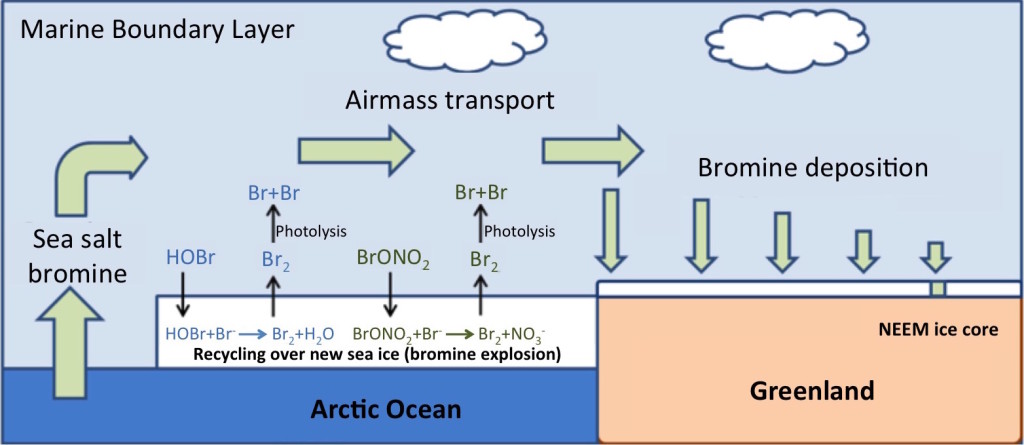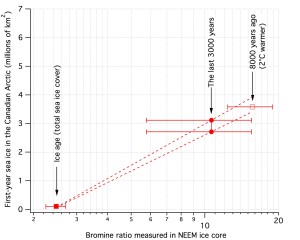Ice2Ice members from Centre for Ice and Climate recently published an article in the Nature-affiliated journal Scientific Reports titled “Canadian Arctic sea ice reconstructed from bromine in the Greenland NEEM ice core”. Here you can read the corresponding author Paul Vallelonga’s explanation of the key findings in this new article.
Arctic sea ice: have we reached a climate threshold?
By Paul Vallelonga, Centre for Ice and Climate
What is happening to Arctic sea ice?
There are two kinds of sea ice in the Arctic – new, thin, sea ice that grows in the winter and melts in the summer (called seasonal or first-year sea ice); and older, thicker, sea ice that survives through the summer and continues to grow each winter (called multi-year sea ice). In the Arctic Ocean there is a central patch of multi-year sea ice, around which the seasonal sea ice grows in the winter and then breaks up and melts in the summer every year. When satellite measurements began in the 1970’s, the amount of old multi-year sea ice was 6 million km2, with more (9 million km2) seasonal sea ice growing around it each year. In the last decade, the amount of old multi-year sea ice has decreased – in 2016 it was 4 million km2 – which means that during the summer, less of the Arctic is covered by sea ice; and during the winter more of the sea ice is thin seasonal sea ice. There is an overall shift toward less Arctic sea ice throughout the year, and a greater proportion of that sea ice being the thin seasonal type.

Is the sea ice decrease since the 1970’s normal or extreme? Are these recent changes within the range of natural variability or has the Arctic system crossed some kind of natural threshold? The only way we can know the answer is by measuring how much Arctic sea ice there was in the past. This new study of ice cores published in the Nature-affiliated journal Scientific Reports takes us closer to finding out – giving us a measure of how much Arctic sea ice there was during three key time intervals: 1) 20 thousand years ago during the last ice age – when Greenland temperatures were about 20° colder; 2) 8 thousand years ago when Greenland temperatures were 2° warmer, known as the early-Holocene period; and 3) during the last 3 thousand years of “normal” Arctic climate.
How to reconstruct sea ice from Greenland ice cores?
The key advance here is the use of a chemical marker called bromine, which we have been able to link to seasonal sea ice. Bromine is present in seawater in small amounts – for every kilogram of seawater there are about 11 grams of sodium but just 7 milligrams of bromine – a thousand times less bromine than sodium. The ratio of bromine to sodium in seawater is the same in all oceans, but we have found that seasonal sea ice concentrates bromine much more than sodium. This bromine concentration enrichment is due to two processes:
- Firstly the process of making seasonal sea ice concentrates sea salts (including bromine) into surface crystals (frost flowers) and salty brine channels, which are able to react with the atmosphere. This rich salty soup is only present in seasonal sea ice because the multi-year sea ice doesn’t contain brine or host surface salt crystals.
- The second ingredient is sunlight. In March and April, Arctic springtime begins with sunlight appearing over the horizon and illuminating freshly-formed seasonal sea ice. The sunlight activates many photochemical reactions; one of the most important is the break-up of bromine gas (Br2) released from the seasonal sea ice surface. When bromine gas splits into two bromine radicals, the radicals start new reactions in the sea ice which lead to the production of more bromine gas. This chain reaction is called a bromine explosion, resulting in an enhanced concentration of bromine in the atmosphere above seasonal sea ice in the Arctic.
In a previous study (Spolaor et al., 2014) we looked at snow and ice in Greenland (at the NEEM ice core drilling site) and Antarctica (from a near-coastal site in East Antarctica called Law Dome) and found a regular spring/summer bromine enrichment peak, matching the seasonal pattern expected from chemical theory and satellite measurements. Bromine was measured in the NEEM ice core using an Inductively Coupled Plasma Mass Spectrometer (ICPMS) instrument located at the University Ca’ Foscari in Venice. The ICPMS is able to separate bromine from other elements such as sodium, and measure their concentrations very precisely. It took about two months to measure the 350 ice core samples from the NEEM ice core.

What have we found?
We have looked at three different climate periods to interpret the NEEM ice core data:
- The coldest part of the ice age, 20 thousand years ago when Greenland was 20°C colder than today.
- The warmest part of the Holocene, 8 thousand years ago when Greenland was 2°C warmer than today.
- The “recent” period in Greenland covering the last 3 thousand years.
We’ve found that the average bromine enrichment – indicating the amount of seasonal sea ice – over the last 3 thousand years is more than the glacial but less than the warm early-Holocene period 8 thousand years ago. This suggests that the amount of seasonal sea ice during the last 3 thousand years is lower on average than it was 8 thousand years ago, just after the end of the last ice age. The results also indicate that multi-year sea ice will continue to decline into the future as the Arctic warms.
So we cannot yet answer the question “have we reached a climate threshold?” but we do know there was less multi-year sea ice 8 thousand years ago, when Greenland climate was just 2°C warmer, compared to the situation over the last 3 thousand years. This research sets up a whole range of new questions to ask:
- How do the sea ice changes over the last 30 years compare to the last 3 thousand years?
- What is the bromine record like at other places in Greenland?
- What can bromine tell us about sea ice during the Eemian warm climate period before the last ice age, when Greenland temperatures were at least 5°C warmer than today?

Where to next?
In the future we plan to expand the published study in two ways – we want to study in more detail the sea ice changes that occurred during the last ice age; and we want to compare the NEEM results to other locations in Greenland. From the published NEEM bromine record, we see that sea ice also changed during the last ice age, particularly during the rapid warming events known as Dansgaard-Oeschger events. Investigating sea ice changes during the glacial is a key goal of the ice2ice project. Also, we are keen to produce sea ice records from bromine measured in East Greenland ice cores, such as Renland and EastGRIP. These ice cores collect sea salts from the Nordic Seas and allow us to study sea ice changes in a different part of the Arctic Ocean. This will tell us more about how sea ice has changed in the Arctic and the role that Atlantic Ocean circulation changes might play in building or destroying sea ice in the Arctic. These newer ice cores will also allow us to collect bromine measurements covering the last 30 years to compare with the satellite observations of sea ice.
Link to the published paper: http://www.nature.com/articles/srep33925
References:
- Spolaor, A. et al. Canadian Arctic sea ice reconstructed from bromine in the Greenland NEEM ice core. Scientific Reports 6, 33925 (2016) doi: 10.1038/srep33925. http://www.nature.com/articles/srep33925
- Spolaor, A. et al. Seasonality of halogen deposition in polar snow and ice. Atmos. Chem. Phys. 14, 9613-9622 (2014) doi: 10.5194/acp-14-9613-2014. http://www.atmos-chem-phys.net/14/9613/2014/acp-14-9613-2014.html
- Simpson, W. R. et al. Halogens and their role in polar boundary-layer ozone depletion. Atmos. Chem. Phys. 7, 4375-4418 (2007) doi: 10.5194/acp-7-4375-2007. http://www.atmos-chem-phys.net/7/4375/2007/